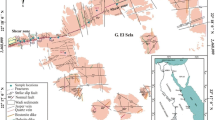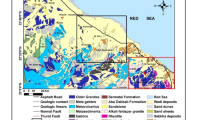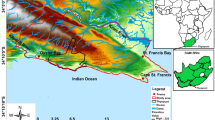Abstract
This study assessed the radiological hazard indices caused by radionuclides in heavy minerals hosted in Taiwanese beaches, streams, and rocks. Apatite, zircon, monazite, xenotime, rutile, sphene, and epidote are counted as radioactive minerals that respond to radiological hazard indices. These indices are lower than the international permitted values that do not endanger human health. Rocks with uranium migrated out (− Um) are considered radioactive mineral sources with negative migration rates ranging between − 2.18 and − 91.52%, with an average of − 46.85%, and are redistributed into beaches and stream sediments, with positive migration rates ranging between 3.76 and 79.55%, with an average of 41.66%.































Similar content being viewed by others
References
UNSCEAR, United Nations Scientific Committee on the Effects of Atomic Radiation (2000) Report to the general assembly Annex B: exposures from natural radiation sources (NY: UN)
Kapdan E, Karahan A (2011) Radioactivity levels and health risks due to radionuclides in the soil of Yalova, Northwestern Turkey. Int J Environ Res 5:837–846
Fallah M, Jahangiri S, Janadeleh H, Kameli MA (2019) Distribution and risk assessment of radionuclides in river sediments along the Arvand River. Iran Microchem J 146:1090–1094. https://doi.org/10.1016/j.microc.2019.02.028
Faure G (1986) Principles of isotope geology, 2nd edn. Wiley, New York, p 589
Abbasi A, Zakaly HMH, Mirekhtiary F (2020) Baseline levels of natural radionuclides concentration in sediments east coastline of North Cyprus. Mar Pollut Bull 16:111793. https://doi.org/10.1016/j.marpolbul.2020.111793
Abbasi A, Zakaly HMH, Badawi A (2021) The anthropogenic radiotoxic element of 137Cs accumulate to biota in the Mediterranean Sea. Mar Pollut Bull 164:112043. https://doi.org/10.1016/j.marpolbul.2021.112043
Eisebud M (1987) Environmental radioactivity from natural, industrial and military sources, 3rd edn. Academic Press, San Diego
Kurnaz A, Küçükömeroğlu B, Keser R, Okumusoglu NT, Korkmaz F, Karahan G, Çevik U (2007) Determination of radioactivity levels and hazards of soil and sediment samples in Firtina Valley (Rize, Turkey). Appl Radiat Isot 65:1281–1289
Alfonso JA, Pérez K, Palacios D, Handt H, LaBrecque JJ, Mora A, Vásquez Y (2014) Distribution and environmental impact of radionuclides in marine sediments along the Venezuelan coast. J Radioanal Nucl Chem 300:219–224
IAEA, International Atomic Energy Agency (1982) Generic models and parameters for assessing the environmental transfer of radio-nuclides from routine releases. Saf. Ser. 57:96–97
Navas A, Soto J, Machin J (2002) 238U, 226Ra, 210Pb, 232Th and 40K activities in soil profiles of the Flysch sector (Central Spanish Pyrenees). Appl Radiat Isot 57:579–589
Beck HL (1972) Physics of environmental gamma radiation fields. In: Proc. of second int symp, on the natural radiation environment. Houston, pp 101–131
Dabayneh KM, Mashal LA, Hasan FI (2008) Radioactivity concentration in soil samples in the southern part of the West Bank, Palestine. Radiat Prot Dosim 131:265–271
UNSCEAR, United Nations Scientific Committee on the Effects of Atomic Radiation (1993) Sources, effects and risks of ionizing radiation. New York, UN, Report to the General Assembly with annexes
Kurnaz A, Küçükomeroglu B, Keser R, Okumusoglu NT, Korkmaz F, Karahan G, Çevik U (2007) Determination of radioactivity levels and hazards of soil and sediment samples in Fırtına Valley (Rize, Turkey). Appl Radiat Isot 65:1281–1289. https://doi.org/10.1016/j.apradiso.2007.06.001
Buesseler KO, Jayne SR, Fisher NS, Rypina I, Baumann H, Baumann Z, Breier CF, Douglass EM, George J, Macdonald AM, Miyamoto H, Nishikawa J, Pike SM, Yoshida S (2012) Fukushima-derived radionuclides in the ocean and biota off Japan. Proc Natl Acad Sci 109:5984–5988. https://doi.org/10.1073/pnas.1120794109
Janadeleh H, Kameli MA (2017) Metals contamination in sediment and their bioaccumulation in plants and three fish species from freshwater ecosystem. Toxin Rev 36:297–305. https://doi.org/10.1080/15569543.2017.1309551
Janadeleh H, Kameli MA, Boazar C (2018) Seasonal variations of metal pollution and distribution, sources, and ecological risk of polycyclic aromatic hydrocarbons (PAHs) in sediment of the Al Hawizah wetland, Iran. Hum Ecol Risk Assess Int J 24:886–903. https://doi.org/10.1080/10807039.2016.1277416
Beretka J, Mathew PJ (1985) Natural radioactivity of Australian building materials, industrial wastes and by-products. Health Phys 48:87–95
Tufeil M, Ahmed N, Mirza SM, Mirza NM, Khan HA (1992) Investigation of gamma-ray activity and radiological hazards of the bricks fabricated around Lahor, Paistan. Pak J Sc Ind Res 34:216–220
Jibiri NN, Bankole QS (2006) Soil radioactivity and radiation absorbed dose rates at roadsides in high-traffic density areas in Ibadan Metropolis, Southwestern Nigeria. Radiat Prot Dosim 118(4):453–458
Kazoka AR, Mwalilino J, Mtoni PA (2023) Radiological risk assessment of 226Ra, 228Ra and 40K isotopes in tilapia fish and its granitic environment in singida municipality, Tanzania. Earth 4:540–551. https://doi.org/10.3390/earth4030028
Huy NQ, Luyen TV (2006) Study on external exposure doses from terrestrial radioactivity in Southern Vietnam. Radiat Prot Dosim 118(3):331–336
Saito K, Jacob P (1995) Gamma ray fields in the air due to sources in the ground. Radia Prot Dosim 58:29–45
Faanhof A (1999) The measurement of natural radioactivity and the impact on humans. Cesk Cas Fys 49:281–296
Asgharizadeh F, Ghannadi M, Samani AB, Meftahi M, Shalibayk M, Sahafipour SA, Gooya ES (2013) Natural radioactivity in surface soil samples from dwelling areas in Tehran city, Iran. Radia Prot Dosim 156(3):376–382. https://doi.org/10.1093/rpd/nct067
Deymar S, Yazdi M, Rezvanianzadeh MR, Behzadi M (2018) Alkali metasomatism as a process for Ti–REE–Y–U–Th mineralization in the Saghand Anomaly 5, Central Iran: Insights from geochemical, mineralogical, and stable isotope data. Ore Geol Rev 93:308–336
Ravisankar R, Chandramohan J, Chandrasekaran A, Prince Prakash Jebakumar J, Vijayalakshmi I, Vijayagopal P, Venkatraman B (2015) Assessments of radioactivity concentration of natural radionuclides and radiological hazard indices in sediment samples from the East coast of Tamilnadu, India with statistical approach. Mar Pollut Bull 97:419–430. https://doi.org/10.1016/j.marpolbul.2015.05.058
Yii MW, Zaharudin A, Abdul-Kadir I (2009) Distribution of naturally occurring radionuclides activity concentration in east Malaysian marine sediment. Appl Radiat Isot 67:630–635. https://doi.org/10.1016/j.apradiso.2008.11.019
Dooley JR, Harshman EN, Rosholt JN (1974) Uranium-Lead Ages of the uranium deposits of the Gas Hills and Shirley Basin, Wyoming. Econ Geol 69:527–531
Deer WA, Howie RA, Zussman J (1992) An introduction to the Rock-Forming Minerals, 2nd edn. Longman, London, p 696
Hoskin PWO (2005) Trace-element composition of hydrothermal zircon and the alteration of Hadean zircon from the Jack Hills, Australia. Geochim Cosmochim A 69:637–648
Žáček V, Škoda R, Sulovský P (2009) U-Th-rich zircon, thorite and allanite-(Ce) as main carriers of radioactivity in the highly radioactive ultrapotassic melasyenite porphyry from the Šumava Mts., Moldanubian Zone, Czech Republic. J Geosci 54/4:343–354
Mezger K, Hanson GN, Bohlen SR (1989) High-precision U-Pb ages of metamorphic rutiles: application to the cooling history of high-grade terranes. E Planet Sci Lett. 96:106–118
Korneliussen A, Ihien P (2002) Laser-ablation ICP-Ms analyses of rutile from the Bamble region, S. Norway. Geologic survey of Norway, NGU report, 112
Papadopoulos A, Christofides G, Koroneos A, Hauzenberger C (2015) U, Th and REE content of heavy minerals from beach sand samples of Sithonia Peninsula (northern Greece). J Minera Geochem 192(2):107–116. https://doi.org/10.1127/njma/2015/0274
Järvelill J-I, Koch R, Raukas A, Vaasma T (2018) Hazardous radioactivity levels and heavy mineral concentrations in beach sediments of Lake Peipsi, northeastern Estonia. Geologo 24(1):1–12
Tsai T-L, Lin C-C, Chuang C-Y, Wei H-J, Men L-C (2011) The effects of physico-chemical properties on natural radioactivity levels, associated dose rate and evaluation of radiation hazard in the soil of Taiwan using statistical analysis. J Radioanal Nuclear Chem 2883:927–936. https://doi.org/10.1007/s10967-011-1032-z
Henningsen D (1967) Crushing of sedimentary rock samples and its effect on shape and number of heavy minerals. Sedimentology 8:253–255
Mitwally EMA, Yu B-S (2022) Geochemistry of magnetite in beach sands, stream sediments, and in situ magnetites in surrounding rocks at north Taiwan island. Acta Geochim. https://doi.org/10.1007/s11631-021-00521-y
Mitwally EMA, Yu B-Sh (2023a) Geochemical studies and resource potential of magnetite in Taiwanese beach sands and related source rocks: Implications for geochemical fingerprinting of ore minerals. Ore Geol Rev. Accepted and in publishing and rights
Mitwally EMA, Yu B-Sh (2023b) Geochemical compatibility and discrimination elements of magnetite on the eastern and western beaches of Taiwan. Environ Earth Sci. Accepted and in publishing and rights
Evans RD (1969) The atomic nucleus. MC Graw-Hill, New York
Marolin M (1991) Construction and use of spectrometric calibration pads laboratory y-ray spectrometry, NMA, Egypt. A report to the government of the Arab Republic of Egypt. Project EGY/4/030-03
Hamby DM, Tynybekov AK (2000) Uranium, thorium and potassium in soils along the shore of lake Issyk-Kyol in the Kyrghyz Republic. Environ Monit Assess 73:101–108
Al-Jundi J (2002) Population doses from terrestrial gamma exposure in areas near to old phosphate mine, Russaifa, Jordan. Radiat Meas 35:23–28
Tzortzis M, Tsertos H, Chirstofides S, Christodoulides G (2003) Gamma ray measurements of naturally occurring radioactive samples from Cyprus characteristic geological rocks. Radiat Meas 37:221–229
IAEA, International Atomic Energy Agency (1988) Geochemical exploration for uranium. Technical Report S. No, 284
ICRP (1991) ICRP Publication 60 radiation protection. Recommendations of the International Commission on Radiological Protection. Am IC RP21, 1–3
Grasety RL, Carson JM, Charbonneau BW, Holman PB (1984) Natural background radiation in Canada. Geol Surv Can Bull 360
Knoll GF (2000) Radiation detection and measurement, 3rd edn. Wiley, New Jersey
IAEA, International Atomic Energy Agency (1979) Gamma-ray surveys in uranium exploration. Technical reports series no. 186, Vienna, 89
Zakaly HM, Uosif MA, Madkour H, Tammam M, Issa S, Elsaman R, El-Taher A (2019) Assessment of natural radionuclides and heavy metal concentrations in marine sediments in view of tourism activities in Hurghada city, northern Red Sea, Egypt. J Phys Sci 30:21–47
Örgün Y, Altinsoy N, ¸Sahin SY, Güngör Y, Gültekin AH, Karahan G, Karacik Z (2007) Natural and anthropogenic radionuclides in rocks and beach sands from Ezine region (Çanakkale), Western Anatolia, Turkey. Appl Radiat Isot 65:739–747
Ahmed RS, Mohammed RS, Abdaljalil RO (2018) The activity concentrations and radium equivalent activity in soil samples collected from the eastern part of Basrah governorate in southern Iraq. Int J Anal Chem 4:1–11. https://doi.org/10.1155/2018/2541020
Read D, Lawless TA, Sims RJ, Butter KR (1993) Uranium migration through intact sandstone cores. J Contam Hydro 13(1–4):277–289. https://doi.org/10.1016/0169-7722(93)90066-2
Tawfic AF, Zakaly HMH, Awad HA, Tantawy HR, Abbasi A, Abed NS, Mostafa M (2021) Natural radioactivity levels and radiological implications in the high natural radiation area of Wadi El Reddah, Egypt. J Radioanal Nucl Chem 327:643–652
Darnely AG (1982) Hot granite: some general remarks. In: Maurice YT (ed) Uranium in granites. Geological Survey of Canada 81/23: l–10
Vera Tme F, Blanco Rodriguez P, Lozano JC (2002) Distribution of U, Th, and Ra in the plant-soil components of a mineralized uranium area in the south-west of Spain. J Environ Radioact 59:41–60
El Galy MM, El Mezayn AM, Said AF, El Mowafya AA, Mohamed MS (2008) Distribution and environmental impacts of some radionuclides in sedimentary rocks at Wadi Naseib area, southwest Sinai. Egypt J Environ Radioact 99:1075–1082
Sroor A, Afifi SY, Abdel-Haleem AS, Salman AB, Abdel-Sammad M (2002) Environmental pollutant isotope measurements and natural radioactivity assessment for North Tushki area, Southwestern Desert, Egypt. Appl Radiat Isot 57:427–436
Zakaly HMH, Uosif MAM, Issa SAM, Tekin HO, Madkour H, Tammam M, El-Taher A, Alharshan GA, Mostafa MYA (2021) An extended assessment of natural radioactivity in the sediments of the mid-region of the Egyptian Red Sea coast. Mar Pollut Bull 171:112658
Mehboob K, Alzahrani YA, Fallatah O, Qutub MMT, Younis H (2020) Radioactivity and radiation hazard indices assessment for phosphate rock samples from Al-Jalamid, Turaif, Umm Wu’al, and As-Sanam, Saudi Arabia. Arab J Sci Eng 46:779–792. https://doi.org/10.1007/s13369-020-04929-1
Awad HA, Zakaly HMH, Nastavkin AV, El Tohamy AM, El-Taher A (2021) Radioactive mineralizations on granitic rocks and silica veins on shear zone of El-Missikat area, Central Eastern Desert, Egypt. Appl Radiat Isot 168:109493
Acknowledgements
The authors thank the Egyptian Nuclear Materials Authority (ENMA) for their assistance with γ-ray spectrometers. We acknowledge constructive comments and suggestions from the Springer Nature Language Editing services to improve the English language of this paper. Special thanks are extended to the anonymous journal reviewers for their constructive comments and suggestions.
Author information
Authors and Affiliations
Corresponding author
Additional information
Publisher's Note
Springer Nature remains neutral with regard to jurisdictional claims in published maps and institutional affiliations.
Supplementary Information
Below is the link to the electronic supplementary material.
Rights and permissions
Springer Nature or its licensor (e.g. a society or other partner) holds exclusive rights to this article under a publishing agreement with the author(s) or other rightsholder(s); author self-archiving of the accepted manuscript version of this article is solely governed by the terms of such publishing agreement and applicable law.
About this article
Cite this article
Mitwally, E.M.A., Yu, BS. Assessment of radiological hazard indices caused by 238U, 232Th, 226Ra and 40K radionuclides of heavy minerals on Taiwanese beach sands, stream sediments, and surrounding rocks: implications for radiometric fingerprinting of the environmental impact. J Radioanal Nucl Chem 332, 4847–4875 (2023). https://doi.org/10.1007/s10967-023-09186-8
Received:
Accepted:
Published:
Issue Date:
DOI: https://doi.org/10.1007/s10967-023-09186-8




